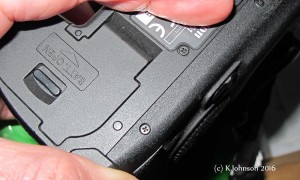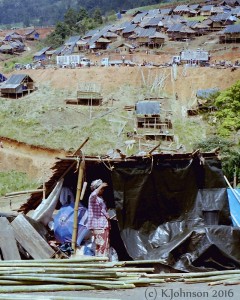The other day I picked up my high-end, relatively expensive DSLR camera and noticed a rattle – a little metallic tinkle when I gave it a shake. I shrugged, turned the camera on, and … nothing happened. A sharp pang of dread struck just below my left shoulder blade (the place dread tends to nest). Trying to be practical, I popped out the battery pack and stuck it on the charger. I must have left the camera on and flattened the battery, I thought to myself. Once the charger gave me the happy green blink, telling me the pack was full, I popped it back into the camera and flicked the switch. The camera came on, but the display indicated “No Battery.”
Then gave me an error message.
Then died.
Dread turned to panic. This is a cherished piece of equipment and if I had to send it in, it would be gone for weeks, if not months, and was bound to be an expensive fix. Like any modern adult, my next move was to go online to search for some indication of what might be the matter. After much research, I found that mine was a common problem, just an internal screw that can work itself loose. I also found a video on YouTube showing how to solve the problem. The person posting it stated that doing-it-yourself could seriously mess up my camera and suggested that if I had any hesitation, I probably shouldn’t partake in this repair.
Pause.
Should I do this myself? Would I just make it worse?
I had hesitated for a moment, but, watching the video again, the repair looked simple enough. I should be able to do it. After all, I’ve spent years in the NGO world, training in the fine art of taking a deep breath and just dealing with it.
When you are living super-rural or in, let’s call them challenging circumstances, self-reliance is an invaluable trait. Back in the late ’90s and early 2000s there was no instant internet, chat-rooms, or blogs to refer to. There wasn’t always someone on the end of the telephone to guide you. In fact, often there was no telephone at all. If you didn’t have the paper manual, you were on your own. It was important to take every opportunity to learn how things worked, and how to fix them, because you just never knew when the information would come in handy.
In my field laboratories, in the heat and humidity, anything with moving parts could seize with rust, or clog with fungus. Old parts wore out, or simply broke. When I had logistics colleagues, they were more than happy to help, but they weren’t always available.
If you’ve been reading these blogs, you’ll already know that I used to pull apart complicated machinery, such as microscopes, but my maintenance and repair work certainly didn’t stop there. In the field, problems were bound to crop up, and that’s where creativity was key. I traveled nowhere without a roll of duct tape, a Swiss Army knife, and a little bottle of Crazy glue. I have used banana leaves for plates and, like Kelley, cups and utensils hacked from bamboo. It truly is a versatile wood; sharp if you give it an edge, soft when woven into clothes, and sturdy enough to build a house.
My drivers were a wealth of information on basic vehicle repair, and how to get through, or out of, mud. I’m probably a better winter driver here in Canada because they taught me the proper use of tire-chains. They loved to show me things because I was never afraid to get dirty. The water and sanitation boys would explain how concrete molds were used, how to line a well, or repair a pump. I’ve even helped construct a temporary hospital. As in Trusting Bamboo Bridges, I actually did have someone spill a soda (a Coke from the smell) across the keyboard of my laptop. It was still working, but was useless to me with keys sticking down at random times. I was in the middle of nowhere, Sierra Leone. There was no choice. Out those keys came.
As you can imagine, none of this was part of my laboratory technology training. These were the additional skills I acquired along the way. It’s what made my time working in the NGO world so much more interesting.
So when I looked down at my beloved camera, dead, I knew what I had to do. I gathered together the necessary tools, a good source of light, and my husband to bolster my courage. I pried the bottom of the camera off with a plastic knife, and, straightened paper clip at the ready, hunted down that tiny screw.
When I finally had all the pieces back together, reinstalled the battery, turned it on, and it worked, I was overjoyed! There is immense satisfaction in fixing something with your own hands.
These small victories in my present life are all products of my past adventures. All products of learning to be brave; of taking a deep breath and simply saying to myself, “I can do this. I’m not afraid to get a little dirty.”






EXCELLENT!